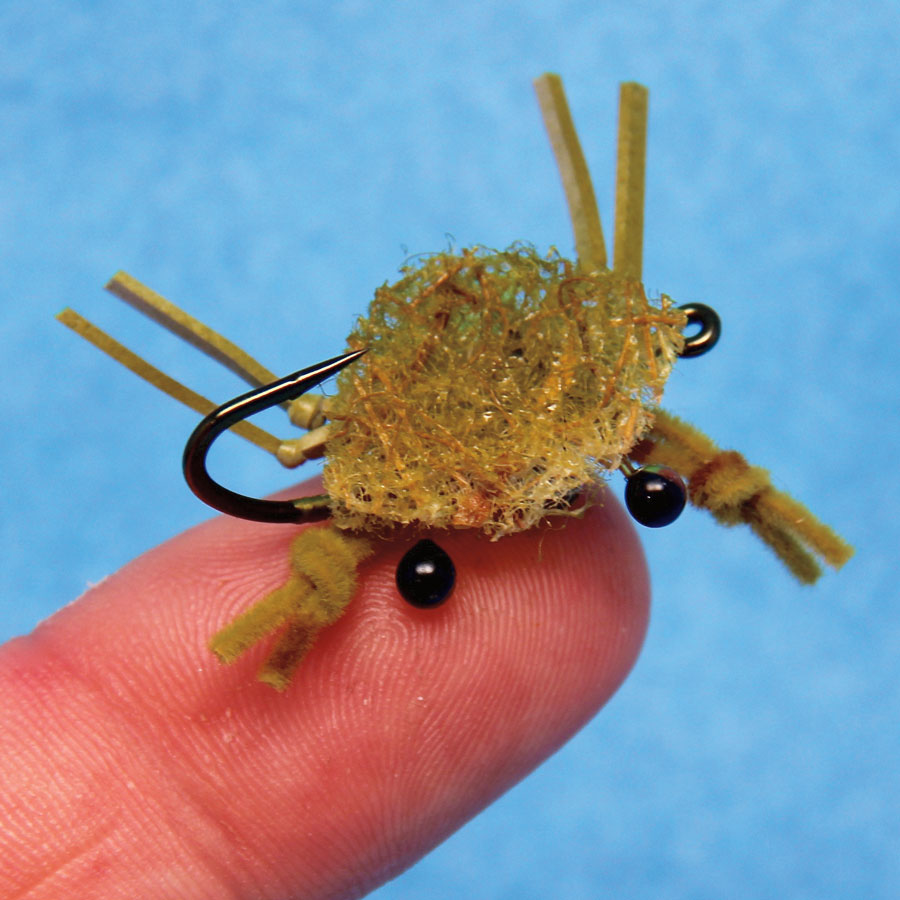The Contraband Crab is a confluence of several of my favorite crab patterns: Bauer Crab, Scotch-Brite Crab and McFly Crab. My goal was to incorporate all my favorite attributes or “abilities” and overcoming each pattern’s shortcomings.
The Bauer Crab is a fly box staple since the 1970s. Its iconic, knotted square rubber legs allow the segment below the knot to be positioned in a rearward-facing direction giving this pattern a very realistic silhouette. When purchasing this pattern from your local fly shop, you will find that the cheap (usually dull) hook is bent to create a larger hook-gape. This weakens the integrity of the hook—not to mention altering its effectiveness. If the eyes are inserted into the wool with too much glue, the wool fibers wick the glue and stiffen as the glue cures, leaving you with a great looking “teaser” with insufficient gape.
The Scotch-Brite pattern is my variation on the Raghead Crab. I did not like the flat, unrealistic look of felt, so I searched for years to replace the material with something that was thicker, more durable and also provided a more mottled look. After a little experimentation, I found that Scotch-Brite pads can be stamped to shape and cut in half to sandwich the hook. This provided the look I was after. But the feather claws were on the rear of the fly, not the front, and the splayed round rubber legs shooting in every direction looked like a spider that was smacked with a flip-flop. Although the round rubber legs were excellent for movement, they were not durable. And they were terrible for holding the color applied with a permanent marker. After being exposed to salt water for a few hours, the color either faded away or smeared everywhere.
The McFly Foam Crab was my fix to the majority of these issues. Yet I ran into some new problems when I tried to scale the pattern down to extremely small sizes. The pattern utilizes a Mustad C68SNP-DT, which is perfect if you are looking for a nickel-sized crab, but this hook was not as effective for matching dime-size crabs or smaller due to the wire thickness in the smaller-sized hooks.
As a commercial fly tier, you can gather a lot of info from the orders that you get based on the location or species the anglers intend to fish. Each year it seems that the flies for all species (especially tarpon and permit) get smaller and smaller as these fish become more pressured and in turn more wary. Matching custom requests is typically not a problem. However, some materials are simply not scalable or available in smaller sizes or colors. With materials such as McFly Foam, using less to create a smaller fly does not respond the same as the original recipe—so you risk losing the realistic look or the functionality for which you picked the material in the first place. As the hook size decreases, so does the hook gape, wire and strength, which becomes a huge issue, especially when it comes to crab patterns for plus-sized permit. The obvious fix would be to go to a larger or wider-gape hook. But this is no improvement if the fly doesn’t look natural and the fish refuse it.
In order for your fly to mimic the intended prey, it must sink at the same speed as a natural. A fly that moves too slowly or too quickly through the water column is a red flag to permit. A refusal usually follows.
Permit have huge eyes for acute vision. They often follow a fly and examine it as it is stripped all the way back to the boat. In the past, I have talked about the idea of black hooks having a tendency to silhouette over white sand and become potentially more visible in clear water. However, over the last few years this hypothesis is believed by many—including me—to be untrue. Larger fish or fish that experience a lot of pressure seem to be more spooked by the glint from a silver hook. Now I tend to tie with both black and silver hooks to hedge for any situation.
When choosing crab patterns to fill your box, I like patterns that can be easily modified on the water and fished effectively anywhere. The materials utilized in the Contraband Crab pattern all hold color well and can be easily modified markers to mimic a unique prey’s colorations that you may encounter on the water.
Materials
Hook: Black Gamakatsu L11s-3H, size 6
Thread: Olive Danville 210 denier Flat Waxed Nylon
Eyes: 5/32nd black nickel brass dumbbell; large black EP Shrimp & Crab Eyes
Legs: Large gray square rubber
Claws: Olive Micro Chenille
Body: Tan Scotch-Brite, Greener Clean Non-Scratch Scour Pad
Adhesive: Clear e6000 Glue; White Tulip Fabric Paint
Marker: Copic YG95 Pale Olive for body; Copic E57 Light Walnut for claws
Tying Steps
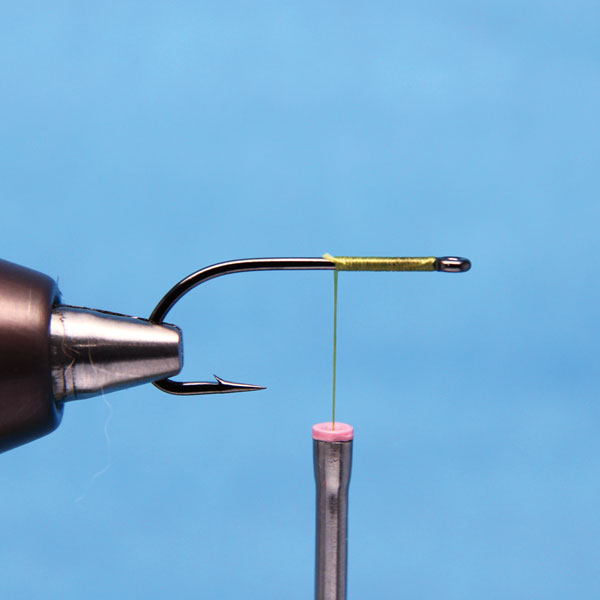 STEP 1: Start the thread at the eye of the hook and wrap backward, creating an even thread layer ending in the middle of the hook shank.
STEP 1: Start the thread at the eye of the hook and wrap backward, creating an even thread layer ending in the middle of the hook shank.
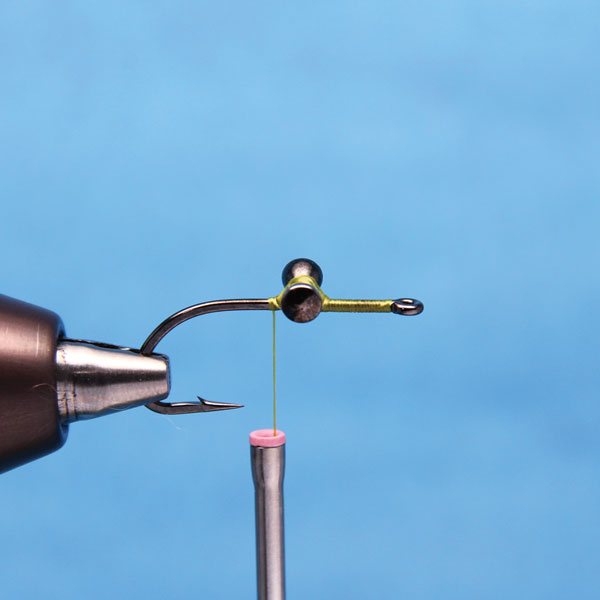 STEP 2: Tie in the dumbbell eyes with a series of tight figure-eight and doughnut wraps.
STEP 2: Tie in the dumbbell eyes with a series of tight figure-eight and doughnut wraps.
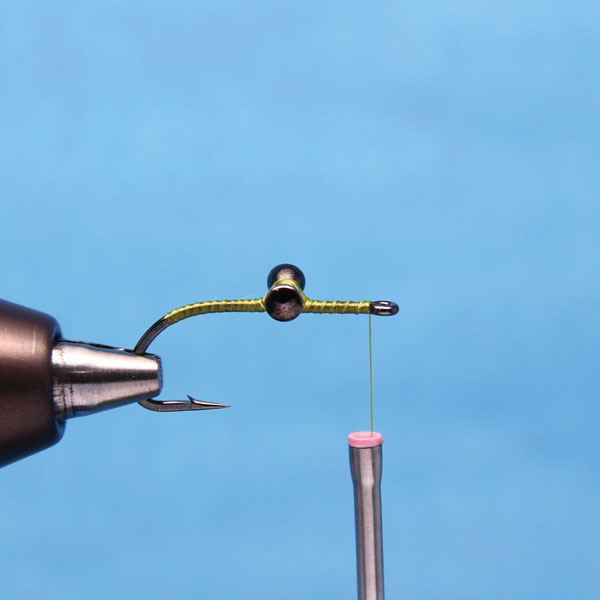 STEP 3: Continue wrapping toward the bend, covering the entire hook shank with an even layer of thread. Once you reach the bend of the hook, advance the thread back to the eye. This layer of thread will provide a better bond when gluing the body of the crab to the hook assembly.
STEP 3: Continue wrapping toward the bend, covering the entire hook shank with an even layer of thread. Once you reach the bend of the hook, advance the thread back to the eye. This layer of thread will provide a better bond when gluing the body of the crab to the hook assembly.
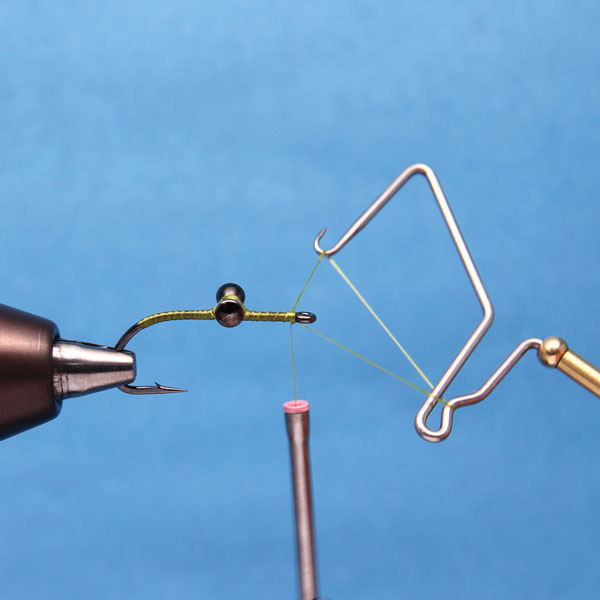 STEP 4: Whip finish at the eye of the hook, cut away the thread and set the prepped hook aside.
STEP 4: Whip finish at the eye of the hook, cut away the thread and set the prepped hook aside.
STEP 5: I like to tie up several of these in advance to save time.
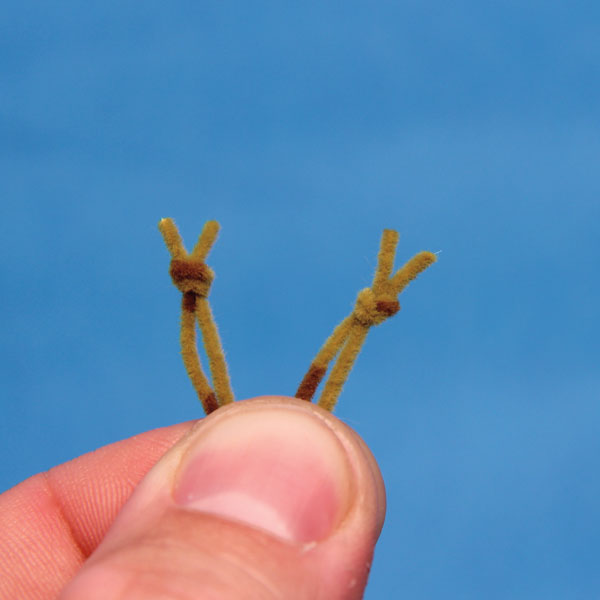 STEP 6: Fold two three-inch pieces of chenille in half and tie a knot about a quarter-inch from the folded end. Cut the loops to create claws. Mark with a brown or olive permanent marker for a mottled look.
STEP 6: Fold two three-inch pieces of chenille in half and tie a knot about a quarter-inch from the folded end. Cut the loops to create claws. Mark with a brown or olive permanent marker for a mottled look.
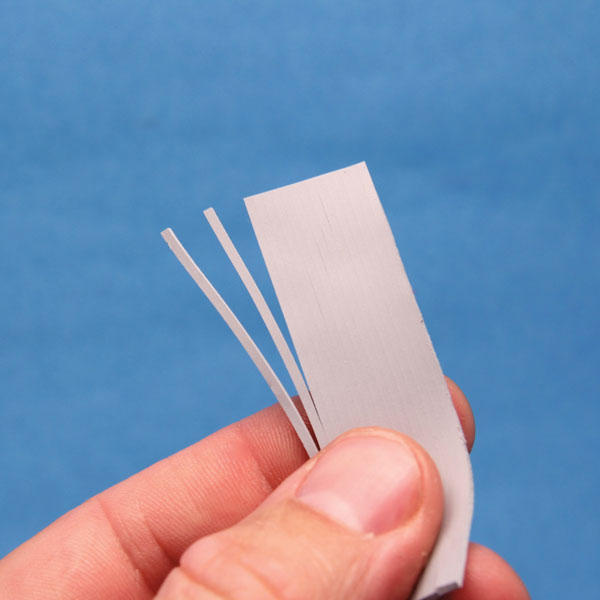 STEP 7: Cut a two-and-a-quarter-inch section of square rubber legs. Separate two legs from the strip.
STEP 7: Cut a two-and-a-quarter-inch section of square rubber legs. Separate two legs from the strip.
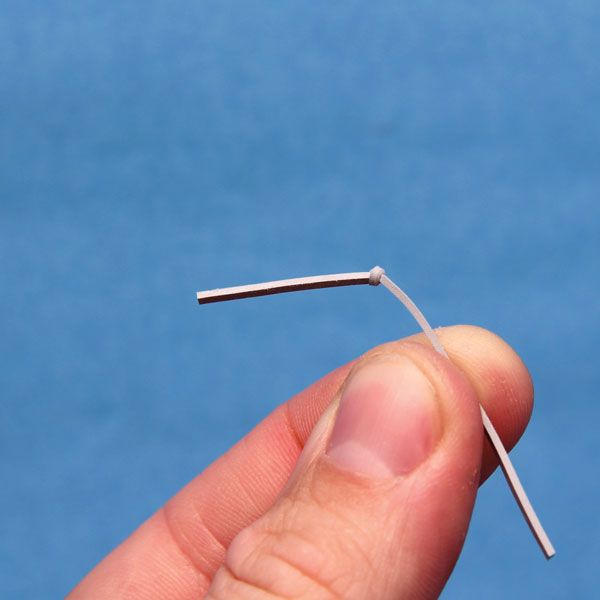 STEP 8: Tie an overhand knot approximately three-quarters of an inch from one end.
STEP 8: Tie an overhand knot approximately three-quarters of an inch from one end.
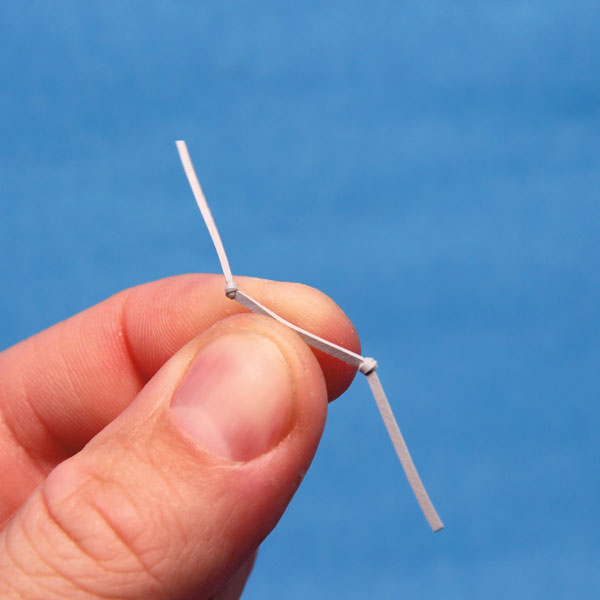 STEP 9: Tie a second knot on the other side of the leg, approximately three-quarters of an inch from the other end. More than likely, the segmented portions of the leg beyond the knot will be facing in different directions, and that is okay.
STEP 9: Tie a second knot on the other side of the leg, approximately three-quarters of an inch from the other end. More than likely, the segmented portions of the leg beyond the knot will be facing in different directions, and that is okay.
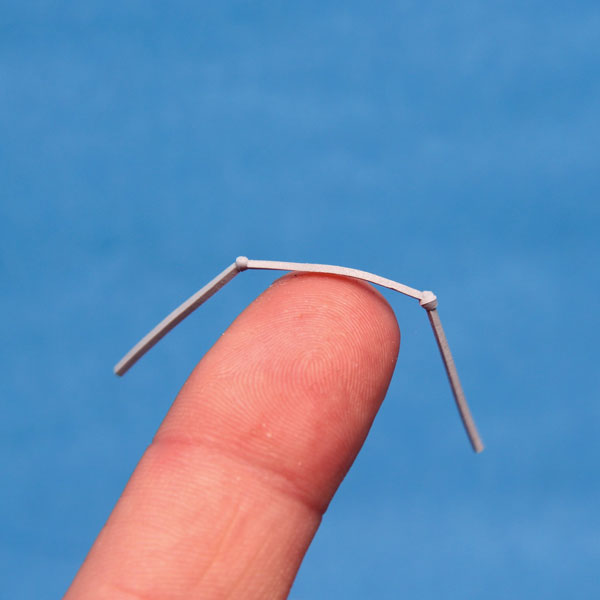 STEP 10: Roll one or both of the knots until the segmented portions of the legs are approximately the same length and are pointing in the same direction. Repeat on the second leg. Do your best to make the knots on the second leg slightly closer together than the first. This is very difficult to achieve and maintain with any kind of consistency using a round rubber leg or thinner flat silicone leg. This is why the square rubber legs are so important.
STEP 10: Roll one or both of the knots until the segmented portions of the legs are approximately the same length and are pointing in the same direction. Repeat on the second leg. Do your best to make the knots on the second leg slightly closer together than the first. This is very difficult to achieve and maintain with any kind of consistency using a round rubber leg or thinner flat silicone leg. This is why the square rubber legs are so important.
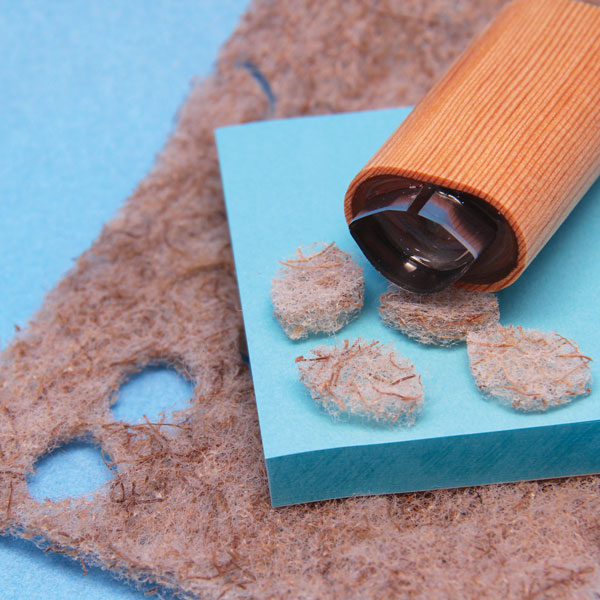 STEP 11: Using a crab-shaped cutter, stamp out the shell of the crab from a sheet of Scotch-Brite, Greener Clean Non-Scratch Scour Pad. If you do not have a crab-shaped cutter, simply trace a dime on the pad and cut it with scissors.
STEP 11: Using a crab-shaped cutter, stamp out the shell of the crab from a sheet of Scotch-Brite, Greener Clean Non-Scratch Scour Pad. If you do not have a crab-shaped cutter, simply trace a dime on the pad and cut it with scissors.
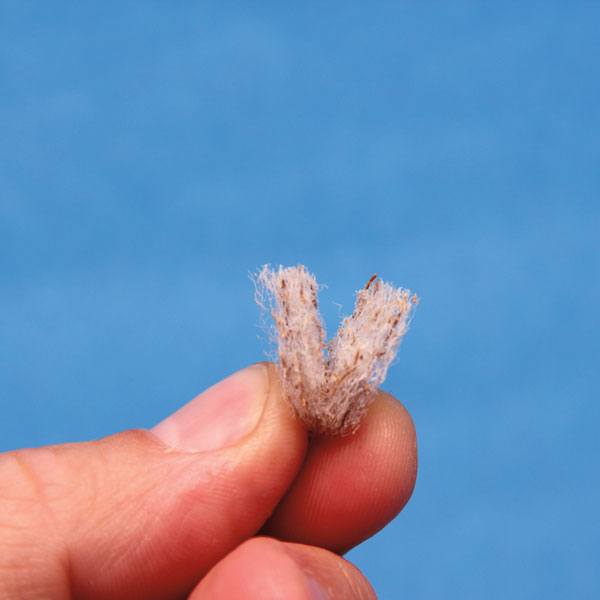 STEP 12: Using a serrated knife or micro-serrated scissors, carefully cut the pad in half from end to end.
STEP 12: Using a serrated knife or micro-serrated scissors, carefully cut the pad in half from end to end.
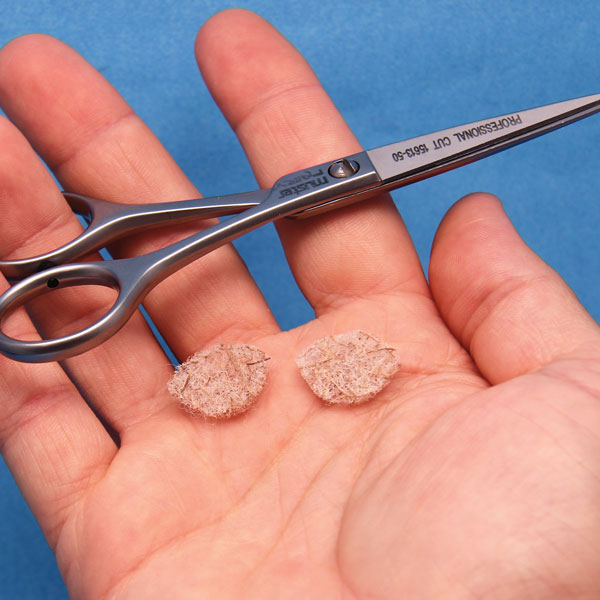 STEP 13: When you are finished, you should have two matching crab bodies, half the width of the original pad. This is essential, because the original pad is too thick and will impede the gape of the hook when the Crab is assembled.
STEP 13: When you are finished, you should have two matching crab bodies, half the width of the original pad. This is essential, because the original pad is too thick and will impede the gape of the hook when the Crab is assembled.
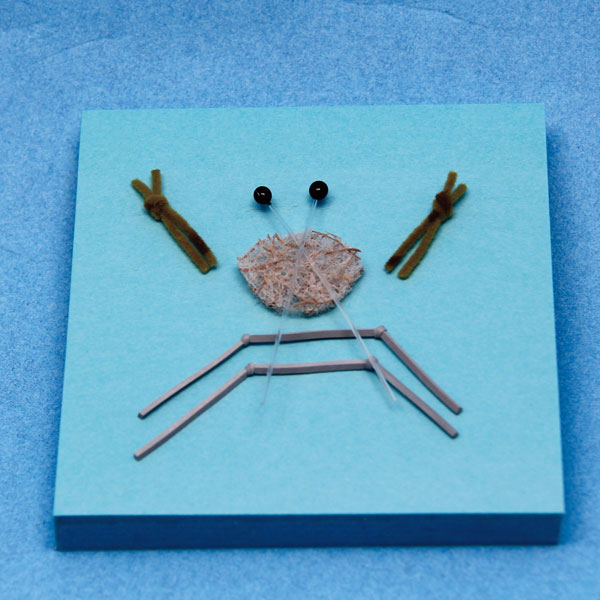 STEP 14: Lay out all the parts of the crab to be assembled. The rubber leg with the knots closer together will be positioned below the other leg. Trim the longer portions of the claws slightly, so they will fit onto the body of the crab.
STEP 14: Lay out all the parts of the crab to be assembled. The rubber leg with the knots closer together will be positioned below the other leg. Trim the longer portions of the claws slightly, so they will fit onto the body of the crab.
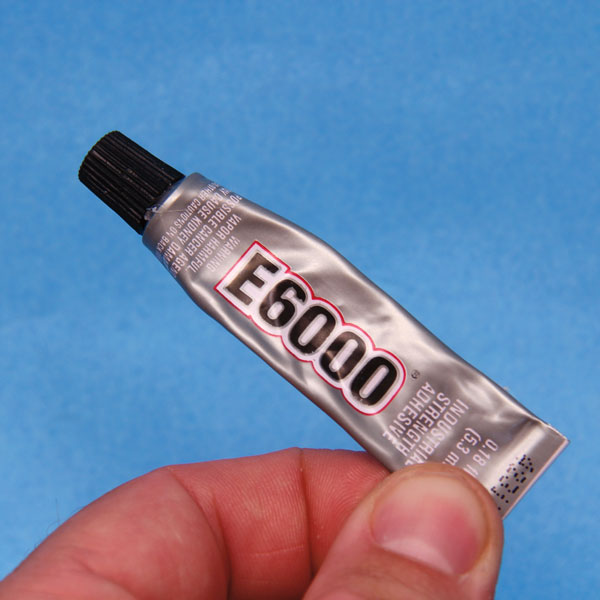 STEP 15: E6000 is the best glue I have found for assembling the crab bodies. If you are tying up multiple bodies at the same time, however, you can substitute the E6000 for fabric paint that matches the desired color of the finished crab. The thinner paint has a tendency to wick through the body material, but it works well to glue the appendages to the body.
STEP 15: E6000 is the best glue I have found for assembling the crab bodies. If you are tying up multiple bodies at the same time, however, you can substitute the E6000 for fabric paint that matches the desired color of the finished crab. The thinner paint has a tendency to wick through the body material, but it works well to glue the appendages to the body.
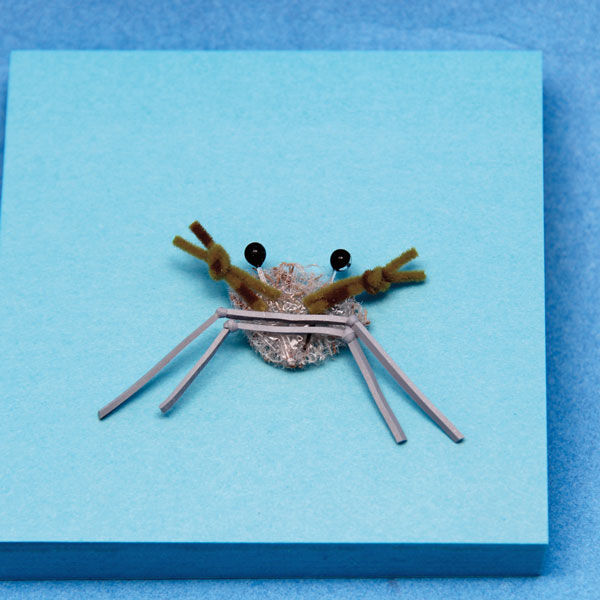 STEP 16: Begin assembly by laying the pair of EP Shrimp & Crab Eyes in to the glue. Cut away the portion of the mono post that sticks out beyond the Scotch-Brite Pad. The black eye should stick out slightly, beyond the body. The butts of the mono post should be angled to create a V shape. Next, place the legs into the glue so that the segmented portions beyond the knots point backward in the same direction. Complete the assembly by placing the claws at a 45-degree angle. The knots of the claws should stick out beyond the Scotch-Brite Pad and line up approximately with the eyes. Set aside to dry.
STEP 16: Begin assembly by laying the pair of EP Shrimp & Crab Eyes in to the glue. Cut away the portion of the mono post that sticks out beyond the Scotch-Brite Pad. The black eye should stick out slightly, beyond the body. The butts of the mono post should be angled to create a V shape. Next, place the legs into the glue so that the segmented portions beyond the knots point backward in the same direction. Complete the assembly by placing the claws at a 45-degree angle. The knots of the claws should stick out beyond the Scotch-Brite Pad and line up approximately with the eyes. Set aside to dry.
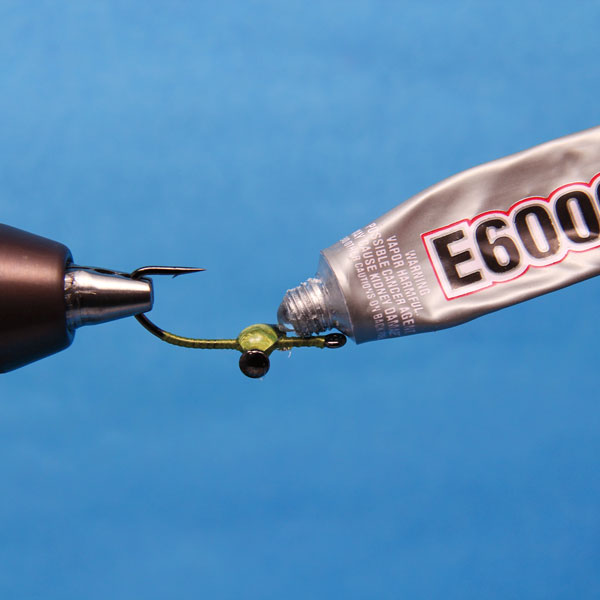 STEP 17: After the body assembly is completely dry, place the hook in the vise, point up. Place a pea-sized bead of glue on top of the hook and above the dumbbell eyes.
STEP 17: After the body assembly is completely dry, place the hook in the vise, point up. Place a pea-sized bead of glue on top of the hook and above the dumbbell eyes.
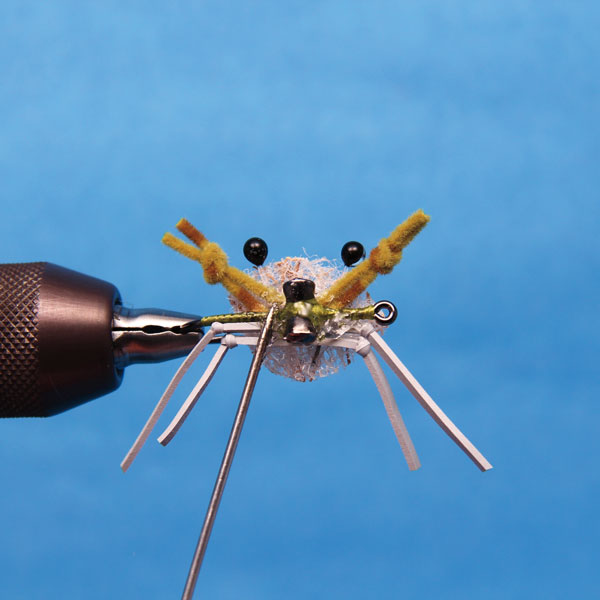 STEP 18: Center the body of the crab on top of the dumbbell eye.
STEP 18: Center the body of the crab on top of the dumbbell eye.
STEP 19: Using a bodkin, spread the glue evenly on the exposed thread wraps and dumbbell eyes. This will create a much better bond between the body and the hook.
STEP 20: With your index finger, press and hold the body in place for 20 to 30 seconds until the glue starts to set up. Make sure that the body does not cover the eye of the hook.
STEP 21: Once the glue is thoroughly dry, trim the segmented portions of the leg to approximately half an inch.
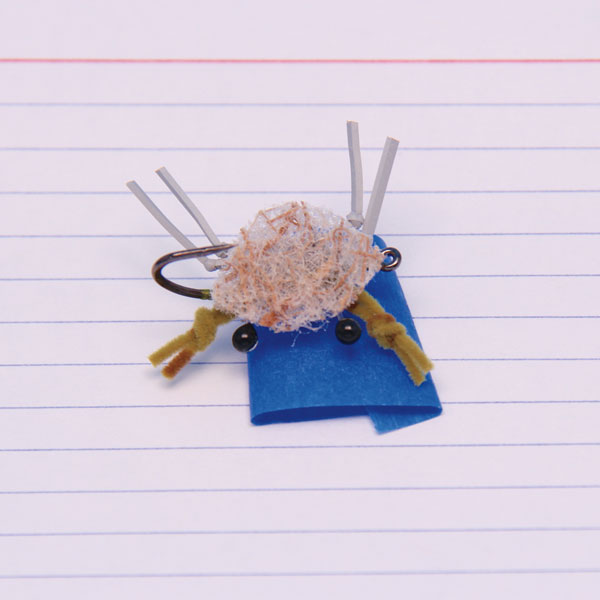 STEP 22: Place a loop of blue painters tape on an index card and stick the crab to the tape on top. This will keep the fly from blowing away when coloring it with the Copic airbrush or markers.
STEP 22: Place a loop of blue painters tape on an index card and stick the crab to the tape on top. This will keep the fly from blowing away when coloring it with the Copic airbrush or markers.
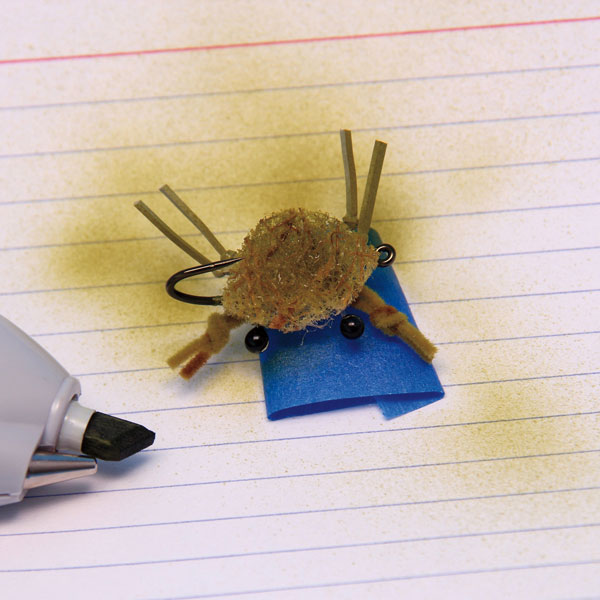 STEP 23: Select your color of choice, and spray the shell and legs of the crab. If you do not have an airbrush, mark these portions with a permanent marker.
STEP 23: Select your color of choice, and spray the shell and legs of the crab. If you do not have an airbrush, mark these portions with a permanent marker.
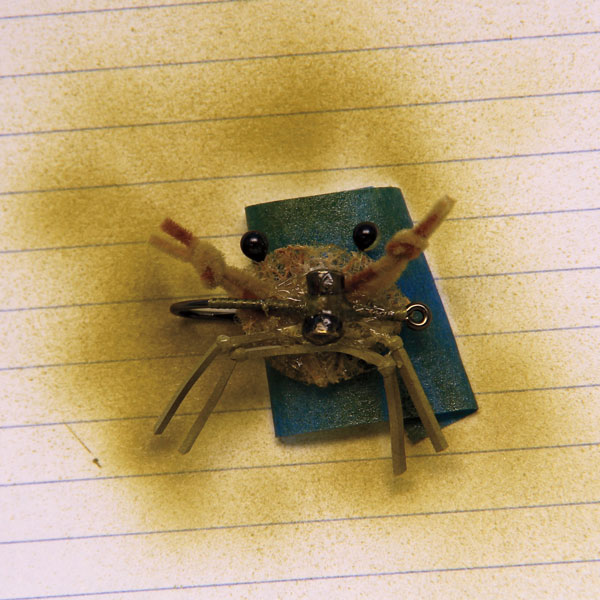 STEP 24: Allow ample time to dry, then turn the fly over and color the underside of the crab. (If using a Copic airbrush, you must spray the fly with a layer of clear coat to insure that the ink does not fade.)
STEP 24: Allow ample time to dry, then turn the fly over and color the underside of the crab. (If using a Copic airbrush, you must spray the fly with a layer of clear coat to insure that the ink does not fade.)
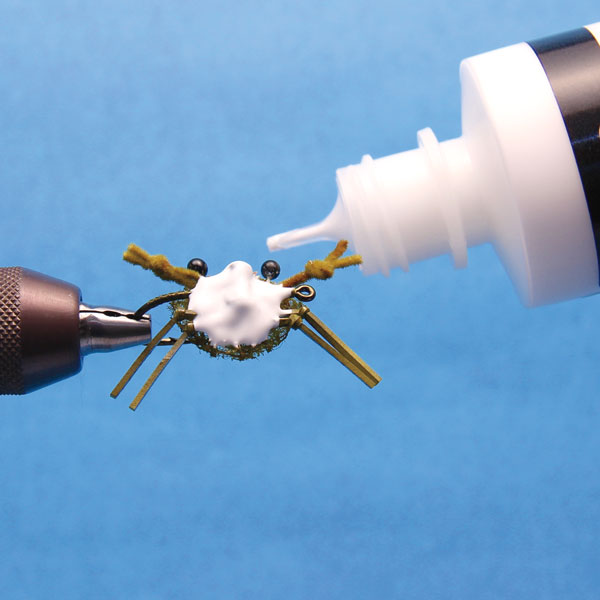 STEP 25: Cover the exposed thread wraps and dumbbell eyes with a thin layer of fabric paint. Most crabs are white on the underside, but feel free to match the fabric paint color to the crabs you are trying to imitate.
STEP 25: Cover the exposed thread wraps and dumbbell eyes with a thin layer of fabric paint. Most crabs are white on the underside, but feel free to match the fabric paint color to the crabs you are trying to imitate.
see more from Drew Chicone at: saltyflytying.com

